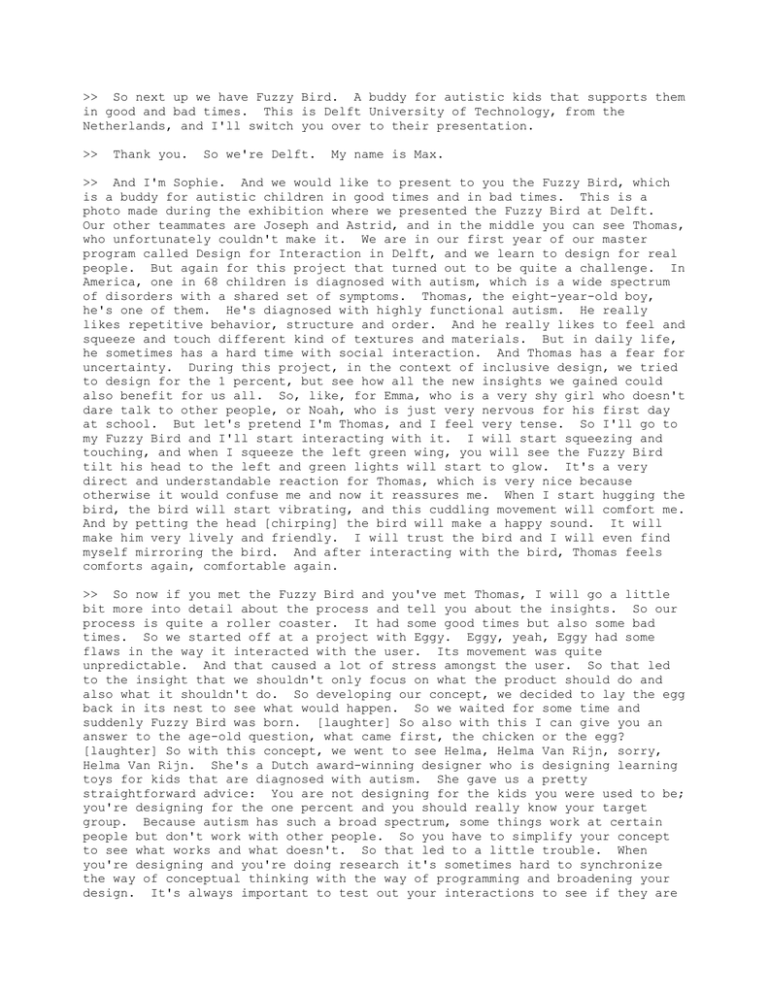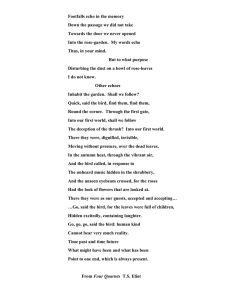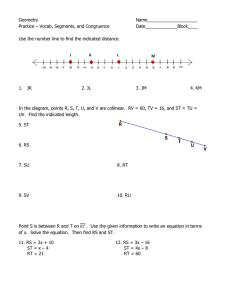>> So next up we have Fuzzy Bird. ... in good and bad times. This is Delft University...
advertisement

>> So next up we have Fuzzy Bird. A buddy for autistic kids that supports them in good and bad times. This is Delft University of Technology, from the Netherlands, and I'll switch you over to their presentation. >> Thank you. So we're Delft. My name is Max. >> And I'm Sophie. And we would like to present to you the Fuzzy Bird, which is a buddy for autistic children in good times and in bad times. This is a photo made during the exhibition where we presented the Fuzzy Bird at Delft. Our other teammates are Joseph and Astrid, and in the middle you can see Thomas, who unfortunately couldn't make it. We are in our first year of our master program called Design for Interaction in Delft, and we learn to design for real people. But again for this project that turned out to be quite a challenge. In America, one in 68 children is diagnosed with autism, which is a wide spectrum of disorders with a shared set of symptoms. Thomas, the eight-year-old boy, he's one of them. He's diagnosed with highly functional autism. He really likes repetitive behavior, structure and order. And he really likes to feel and squeeze and touch different kind of textures and materials. But in daily life, he sometimes has a hard time with social interaction. And Thomas has a fear for uncertainty. During this project, in the context of inclusive design, we tried to design for the 1 percent, but see how all the new insights we gained could also benefit for us all. So, like, for Emma, who is a very shy girl who doesn't dare talk to other people, or Noah, who is just very nervous for his first day at school. But let's pretend I'm Thomas, and I feel very tense. So I'll go to my Fuzzy Bird and I'll start interacting with it. I will start squeezing and touching, and when I squeeze the left green wing, you will see the Fuzzy Bird tilt his head to the left and green lights will start to glow. It's a very direct and understandable reaction for Thomas, which is very nice because otherwise it would confuse me and now it reassures me. When I start hugging the bird, the bird will start vibrating, and this cuddling movement will comfort me. And by petting the head [chirping] the bird will make a happy sound. It will make him very lively and friendly. I will trust the bird and I will even find myself mirroring the bird. And after interacting with the bird, Thomas feels comforts again, comfortable again. >> So now if you met the Fuzzy Bird and you've met Thomas, I will go a little bit more into detail about the process and tell you about the insights. So our process is quite a roller coaster. It had some good times but also some bad times. So we started off at a project with Eggy. Eggy, yeah, Eggy had some flaws in the way it interacted with the user. Its movement was quite unpredictable. And that caused a lot of stress amongst the user. So that led to the insight that we shouldn't only focus on what the product should do and also what it shouldn't do. So developing our concept, we decided to lay the egg back in its nest to see what would happen. So we waited for some time and suddenly Fuzzy Bird was born. [laughter] So also with this I can give you an answer to the age-old question, what came first, the chicken or the egg? [laughter] So with this concept, we went to see Helma, Helma Van Rijn, sorry, Helma Van Rijn. She's a Dutch award-winning designer who is designing learning toys for kids that are diagnosed with autism. She gave us a pretty straightforward advice: You are not designing for the kids you were used to be; you're designing for the one percent and you should really know your target group. Because autism has such a broad spectrum, some things work at certain people but don't work with other people. So you have to simplify your concept to see what works and what doesn't. So that led to a little trouble. When you're designing and you're doing research it's sometimes hard to synchronize the way of conceptual thinking with the way of programming and broadening your design. It's always important to test out your interactions to see if they are working. So sometimes you have to simulate or mimic the technical part in order to see if it's working. That led to our final, or not to a final, but led to a working prototype which we tested at a primary school in Delft. It had some kids with special needs, including Sam, who is highly functional with autism. So we would like to share this impression with you that we made and I really would like to point out the change over time of the facial expression of Thomas or, sorry, Sam, and see how he interacts with the Fuzzy Bird. So Sam is normally quite closed and shy, trying not to have eye contact. He starts to explore what he can do with Fuzzy Bird. He starts hugging. That comforts him. And he dares to speak up. We really think that user testing is one of the most rewarding things in research and design, because you can really test out your concept and see how it works. So I would also like to quote one of the teachers who told us that when Bob was going back to class after playing with Fuzzy Bird, he started interacting with other kids, telling about his experience with the Fuzzy Bird. So we do not only think that the Fuzzy Bird can have an effect on a short term but also maybe also on a long term. So here we are now with the Fuzzy Bird here in Redmond. But we also want to take a look into the future to see what the Fuzzy Bird can do. So I would like to quote one of the psychologists who stopped by at our expo in Delft, and she told her -- she told us that the Fuzzy Bird reminded her of a transitional object. That's an object used by therapists to gain the child's trust and to make him open up and tell about difficult events. So with these insights of inclusive design and designing for the one percent, we can try to find insights that can help us in designing for the rest, and to create a benefit just not only for Thomas but also for Emma and also for Noah. So I would really want you to come to our showcase and experience the Fuzzy Bird yourself. Thanks. [Applause] >> Thank you. That's a great picture. Wednesday. So who would like to start? That also happened between Monday and >> You guys know you're doing well with this. I don't need to tell you. I think -- I don't know, I need a Fuzzy Bird. Sometimes work gets kind of stressful. And so it seems like a rather complicated issue, right? So you're user testing and what you guys -- how many people have you actually tested? >> We've tested with eight different kids. of five to ten. Boys and girls varying from the age >> Very interesting. It's all kind of in the results, right, for what you're going for here. And so a lot more testing, a lot more iterating would be great. I think this concept is really, really strong. It could probably keep going. There's probably quite a bit of innovation, quite a bit of additional features that you could keep adding and a lot more that you can do with it. So that's very exciting and what a great -- this is a platform. Look at this platform. What an awesome platform. So, lovely, lovely. I'll leave it to you for some critique. >> Sure. Great job, guys. I think this is probably the most complete concept out of all the kind of work we're seeing. I love the journey that you're getting here, the fact that your prototype is fully functioning and you pulled off the presentation and demonstration of it really perfectly. That's very commendable and that you subjected this to user evaluation and really learned through prototyping. That's all like just total magic for me in terms of just getting out of the theory, building it and really learning from the hard knocks and the experiences of seeing it in the hands of your target audience. Totally commendable. Love the work. Great job. >> Yeah, very thoughtful. Great storytelling. Beautiful job of putting the story together and telling it and talking about the bits that were a bit, didn't work. Like Eggy, just wasn't there. And the story, it was very neat and very nice. I think the only thing that I would have liked to have seen, just because you've done such a good job, something else, was thinking about other forms for this. I know you went from Eggy to bird. But I kept kind of feeling a little unsure about the form and the bird and the audience you were going for, even once you get to school, would you take that to school with you? And, so, kind of thinking about the world of stuffed animals and what was going to work for people and it being a platform, basically. So that's just kind of next steps really, like what else could you do. But a really nice project. >> Thank you. [Applause] >> We have time for questions from the audience. >> Hi. Really interesting project. I'm very curious if you were able to identify which aspects of Fuzzy Bird the children were responding to? Was it the form of the interaction? Was it the physical shape and the presence of a face or no face or did you have a way of testing that to find out? >> I think they're reacting on both. We did not test how they reacted if it was not a recognizable animal, bird without a face, so that might be very interesting if that's actually necessary. But the direct feedback that the bird gave and I think definitely the features of this softness and somewhere cuteness. I'm not sure if you need the face word, but the movement, that reaction. >> Also the interaction with the bird is sort of human like in a small way. you're touching it, you're trying different stuff. You're cuddly. That can help in things that have to deal with autism. >> Okay. Thank you so much. [Applause] So

